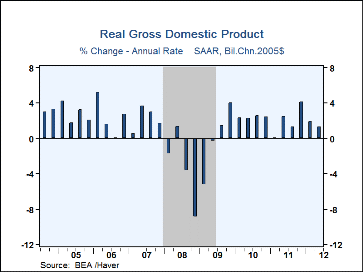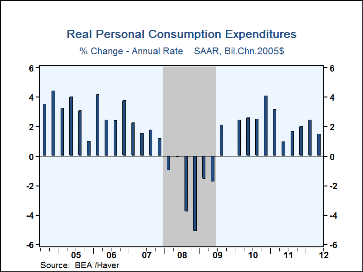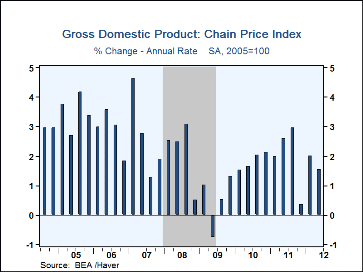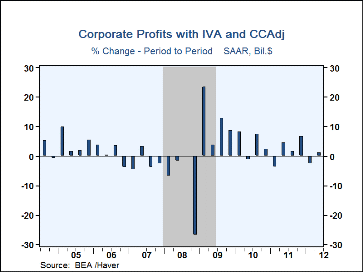 Global| Sep 27 2012
Global| Sep 27 2012U.S. GDP Growth Is Lower Due To Drought Effect
by:Tom Moeller
|in:Economy in Brief
Summary
Last quarter's real GDP growth was unexpectedly revised lower to a 1.3% annual rate following the second estimate of 1.7% growth. Growth was expected to be little-changed. The revision reflected a 0.2 percentage point subtraction from [...]
Last quarter's real GDP growth was unexpectedly revised lower to a 1.3% annual rate following the second estimate of 1.7% growth. Growth was expected to be little-changed. The revision reflected a 0.2 percentage point subtraction from growth due to lower farm inventories. Domestic demand growth also was revised down slightly to 1.4% from 1.6%.
Growth in corporate profits with IVA & CCA for Q2 was revised up slightly to 1.1% (6.7% y/y) following a 2.7% Q1 decline. Profits rose 7.3% last year. After tax profits without IVA & CCA fell 0.8% (+14.6% y/y) after a 9.7% Q1 increase. After tax profits with IVA & CCA rose 2.2% (4.4% y/y) following an 8.6% Q1 decline.
Inventory building subtracted 0.5 percentage points from last quarter's GDP growth, revised down from -0.2% reported last month. Foreign trade deficit improvement was little-revised and added 0.2 percentage points to Q2 growth. Exports grew at a lessened 5.2% annual rate (4.3% y/y) while imports rose at a 2.8% rate (3.9% y/y).
Domestic demand growth was lowered to 1.4% (2.0% y/y). Good weather and low interest rates helped residential investment advance at a downwardly revised 8.4% rate (10.4% y/y). Business fixed investment improved at a lessened 3.6% annual rate (9.7% y/y) while consumer spending grew at an easier 1.5% rate (2.0% y/y). Government spending continued to fall, last quarter at a slightly lessened 0.7% annual rate (-2.2% y/y).
Price inflation as measured by the chain-weight price index rose at a moderated and unrevised 1.6% (1.7% y/y) annual rate.
The latest GDP figures can be found in Haver's USECON and USNA databases; USNA contains basically all of the Bureau of Economic Analysis' detail on the national accounts, including the new integrated economics accounts and the recently added GDP data for U.S. Territories. The Consensus estimates can be found in AS1REPNA.
| Chained 2005 $,% AR | Q2'12 (3rd Est) | Q2'12 (2nd Est) | Q2'12 (Advance) | Q1'12 | Q4'11 | Q2'12 Y/Y |
2011 | 2010 | 2009 |
|---|---|---|---|---|---|---|---|---|---|
| Gross Domestic Product | 1.3 | 1.7 | 1.5 | 2.0 | 4.1 | 2.1 | 1.8 | 2.4 | -3.1 |
| Inventory Effect | -0.5 | -0.2 | 0.3 | -0.4 | 2.6 | 0.1 | -0.2 | 1.5 | -0.8 |
| Final Sales | 1.7 | 2.0 | 1.2 | 2.4 | 1.5 | 2.0 | 2.0 | 0.9 | -2.3 |
| Foreign Trade Effect | 0.2 | 0.3 | -0.3 | 0.2 | -0.6 | 0.0 | 0.2 | -0.4 | 1.0 |
| Domestic Final Sales | 1.4 | 1.6 | 1.5 | 2.2 | 2.1 | 2.0 | 1.8 | 1.3 | -3.3 |
| Demand Components | |||||||||
| Personal Consumption | 1.5 | 1.7 | 1.5 | 2.4 | 2.0 | 1.9 | 2.5 | 1.8 | -1.9 |
| Business Fixed Investment | 3.6 | 4.2 | 5.4 | 7.5 | 9.5 | 9.7 | 8.6 | 0.7 | -18.1 |
| Residential Investment | 8.4 | 8.9 | 9.8 | 20.6 | 12.0 | 10.4 | -1.4 | -3.1 | -22.4 |
| Government Spending | -0.7 | -0.9 | -1.4 | -3.0 | -2.2 | -2.2 | -3.1 | 0.6 | 3.7 |
| Chain-Type Price Index | |||||||||
| GDP | 1.6 | 1.6 | 1.6 | 2.0 | 0.4 | 1.7 | 2.1 | 1.3 | 0.9 |
| Final Sales of Domestic Product | 1.5 | 1.6 | 1.6 | 2.0 | 0.4 | 1.7 | 2.1 | 1.3 | 0.9 |
| Final Sales to Domestic Purchasers | 0.7 | 0.7 | 0.7 | 2.5 | 0.9 | 1.6 | 2.5 | 1.6 | -0.2 |
Tom Moeller
AuthorMore in Author Profile »Prior to joining Haver Analytics in 2000, Mr. Moeller worked as the Economist at Chancellor Capital Management from 1985 to 1999. There, he developed comprehensive economic forecasts and interpreted economic data for equity and fixed income portfolio managers. Also at Chancellor, Mr. Moeller worked as an equity analyst and was responsible for researching and rating companies in the economically sensitive automobile and housing industries for investment in Chancellor’s equity portfolio. Prior to joining Chancellor, Mr. Moeller was an Economist at Citibank from 1979 to 1984. He also analyzed pricing behavior in the metals industry for the Council on Wage and Price Stability in Washington, D.C. In 1999, Mr. Moeller received the award for most accurate forecast from the Forecasters' Club of New York. From 1990 to 1992 he was President of the New York Association for Business Economists. Mr. Moeller earned an M.B.A. in Finance from Fordham University, where he graduated in 1987. He holds a Bachelor of Arts in Economics from George Washington University.










